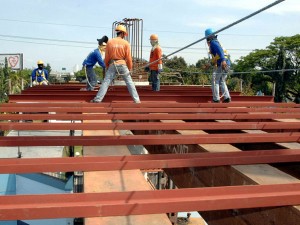PH competitiveness ranking up by 10 notches

Welders and construction workers are seen on a metal frame as they work on an access road to the Ninoy Aquino International Airport Terminal 3 in this file photo. The Philippines leaped by 10 notches in the global competitiveness ranking for 2012 to 65th out of 144 countries. AFP PHOTO/Jay DIRECTO
Enjoying a favorable economic performance and having a government that claims to put premium on its anticorruption drive, the Philippines leaped 10 notches in the global competitiveness ranking for the year to 65th spot out of 144 countries.
The country’s latest performance followed a similar 10-notch jump to the 75th spot last year, resulting in an overall 20-notch jump so far under the Aquino administration.
“The Philippines makes important strides this year in improving competitiveness—albeit often from a very low base—especially with respect to its public institutions,” The World Economic Forum (WEF) said in its 2012-2013 Global Competitiveness Report, which was released Wednesday worldwide.
The WEF said the Philippines was one of the few countries that registered a double-digit improvement in ranking this year.
The Philippines landed on the 65th spot after it registered an overall score of 4.23 points (out of 7 points) across all 12 categories considered by businesses as major areas for determining a country’s competitiveness.
Article continues after this advertisementGuillermo Luz, cochairman of the Philippines’ National Competitiveness Council (NCC), said at a press conference Wednesday that this year was the first time the country landed on the upper 50 percent of countries ranked in the global competitiveness survey.
Article continues after this advertisementHe said the NCC was targeting the Philippines to join the upper one-third of the global competitiveness rankings by 2016, the end of the Aquino administration.
12 pillars
The survey on global competitiveness, which taps businesses as respondents, grades countries based on the following 12 categories or “pillars.”
These are the following: [government] institutions, infrastructure, macroeconomic environment, health and primary education, higher education and training, goods market efficiency, labor market efficiency, financial market development, technological readiness, market size, business sophistication, and innovation.
Luz said the Philippines registered improvements in 11 out of the 12 categories.
Huge gain in institutions
The Philippines gained the most in the “institutions” category, where it jumped 23 places to the 94th spot from last year’s 117th.
In the “infrastructure” category, the country improved its ranking by seven places to 98th; for “macroeconomic environment,” up 18 places to 36th; for “higher education” and training, up seven places to 64th; for goods market efficiency, up two places to 86th; for labor market efficiency, up 10 places to 103rd; for financial market development, up 13 places to 58th; for “technological readiness,” up four places to 79th; for “market size,” up one place to 35th; for “business sophistication,” up eight places to 49th; and for “innovation,” up 14 places to 94th.
Drop in health, primary education
The only category where the Philippines registered a slippage was in “health and primary education,” where it fell six places to 98th.
The country’s favorable performance in the “institutions” category reflects the success of the Aquino administration in convincing the business sector that there has been an improvement in governance, Luz said.
Of the 15,000 businesses that responded to the global competitiveness survey for this year, 132 came from the Philippines.
On macroeconomic environment, Luz attributed the country’s improved ranking to the country’s favorable economic performance.
The Philippine economy grew 5.9 percent in the second quarter from a year ago, making the country one of the fastest-growing economies in Asia. This brought its average growth rate for the first semester to 6.1 percent, making the government’s full-year growth target of 5 to 6 percent attainable.
Infra spending low
But Ramon del Rosario Jr., chairman of the Makati Business Club, said a lot of work still had to be done in several areas to help ensure that the Philippines reaches the upper-third rankings in 2016.
To reach the upper upper third, the country must improve significantly on infrastructure development and market efficiency, particularly labor market efficiency, Del Rosario said.
Despite increases in government spending on infrastructure this year, infrastructure investment in the Philippines remains one of the lowest in the region.
Infrastructure spending in the country is estimated to be equivalent to less than 3 percent of its gross domestic product, below the 5 percent average for Southeast Asia.
“Despite these very positive trends, many weaknesses remain to be addressed. The country’s infrastructure is still in a dire state, particularly with respect to sea and air transport, with little or no progress achieved to date,” Del Rosario said at the press conference.
He said businesses considered infrastructure a vital area in deciding whether to invest in a country.
With its improved performance this year, the Philippines has beaten Vietnam, which enjoyed better rankings in the previous years. This year, Vietnam ranked 75th.
The Philippines, however, continues to lag behind other major Asian economies in the competitiveness rankings.
Hong Kong ranked 9th, Taiwan 13th, South Korea 19th, Malaysia 25th, China 29th, Thailand 38th, Indonesia 50th and India, 59th.
Singapore remained the highest ranking among Asian countries, landing on the second spot, the same as its last year’s ranking.
Switzerland was again named the most globally competitive country.
Originally posted at 09:55 pm | Wednesday, September 05, 2012